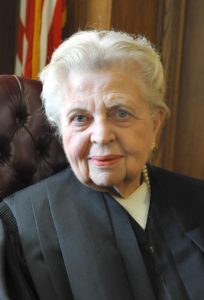I do not believe it is an overstatement to declare that the Texas Panhandle legal community has lost a legendary figure.
Senior U.S. District Judge Mary Lou Robinson was that rare individual whom others aspired to emulate. She died this past weekend at the age of 92. To say she will be “missed” is to say that the Super Bowl is “just another football game.”
During my nearly 18 years as editorial page editor of the Amarillo Globe-News, I was privileged to interview dozens of candidates for state and county judgeships. Most of them were serious about seeking the job and in serving their community and state. Almost to a person they would include a laudatory statement about Judge Robinson. They would say that this veteran jurist set the standard for judicial excellence. They intended to pattern their conduct on the bench after her.
Yes, she was revered by those within the legal community.
Judge Robinson was a pioneering individual. She was the first woman to serve on the Potter County court at law bench; she would serve on the state district court bench and then on the Seventh Court of Appeals. After that she became the first judge appointed to fill a seat in the newly created Northern U.S. Judicial District of Texas. President Carter appointed her in 1980 and she worked full time as a federal judge until only recently, when she took “senior status,” enabling her to preside over trials of her choosing.
And let us not forget her presiding over the widely covered “beef trial” involving Oprah Winfrey, who got sued by some Panhandle cattlemen over a remark she made about mad cow disease during one of her TV shows. The cattlemen wanted the trial to occur in Amarillo, perhaps thinking they could get a favorable ruling from a local judge.
Winfrey prevailed in the lawsuit.
I did not know Judge Robinson well, although we did serve in the same Rotary Club for many years. She was always gracious, even though she knew I was a member of the media. I mention that because Judge Robinson rarely conducted interviews; I always had the sense that she was mildly uncomfortable with those of us who reported on and commented on issues of the day.
I want to share one more quick story. The Globe-News welcomed a young reporter some years ago who I believe was assigned to cover the courts. He wanted to meet Judge Robinson, who he knew only by reputation; he asked me if I could arrange the meeting. I approached the judge at a Rotary Club meeting and asked her if she would be willing to meet this young man. She agreed.
They met in her office in downtown Amarillo and, according to my colleague, she could not have been warmer, more welcoming and gracious. I recall him telling me she wanted to talk mostly “about her grandchildren” and showed off pictures of her family.
The jurists who will continue to seek to emulate this judicial icon could not have chosen a better model.
